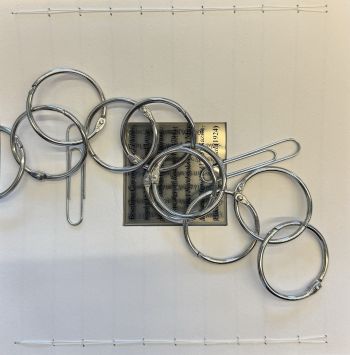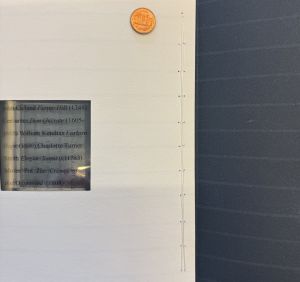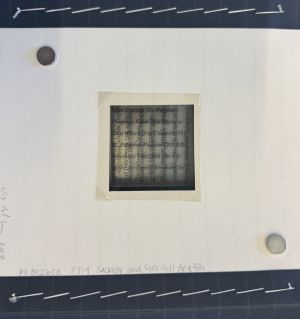The Fettered Lettered

Introduction
The Fettered Lettered, created in Bologna, Italy by Angela Lorenz in 2007, represents incarcerated authors and works written while in confinement — including prison, jail, exile, mental institutions, and other places of confinement. This book was sold to Penn Libraries by Booklyn in 2022 with support from the Ruth and Marvin Sackner Fund for the Arts of the Contemporary Book. Part of the University of Pennsylvania's Kislak Center for Special Collections, Rare Books and Manuscripts, this artists’ book is one of many in the collection. Like many other artists' books, the Fettered Lettered is a highly limited edition, with only 19 copies.
A rough draft of this book was exhibited at the Addison Gallery of American Art from September to December of 2007 in Andover, Massachusetts. This exhibition provided the opportunity for the public to anonymously contribute suggestions of additional incarcerated authors or works written while in confinement.

Genre of the Artists' Book & Significance
The rise of the 20th-century genre of the artists’ book has muddled the very meaning of a book, “resist[ing] definition, taking multiple forms and pursuing multifarious themes.”[1] Many scholars and artists have argued that there is no apt definition of this genre without flattening the diversity of these books (too vague) or being inherently exclusionary (too specific).[2] Artists’ books vary extensively in form, aesthetic, production, circulation, materiality, etc. As Johanna Drucker writes in The Century of Artists’ Books:
“[a]rtists' books take every possible form, participate in every possible convention of book making; every possible ‘ism’ of mainstream art and literature, every possible mode of production, every shape, every degree of ephemerality or archival durability.”[2]
Artists’ books are typically published through independent publishers, which helps to illuminate the history in which the artists’ book is situated — a history of wanting “to make a voice heard, or a vision available…”[2] The genre of the artist’s book is intimately linked to what Drucker refers to as the “activist artist” or the leveraging of art to inspire political or social consciousness and change.[2] Because books can be circulated widely and freely; are low maintenance, long-lasting objects; and formally offer a means to communicate “beyond the limits of an individual life or contacts,” their formal and material aspects have a significant relationship to the typical content.[2]
Many artists’ books are either a unique work; a limited edition; or an inconsistent edition, making them “rare” and/or “auratic” objects.[2] Not only are many artists’ books literally rare, many might seem to have an “auratic” character, producing an unexplainable level of interest or fascination. As Drucker explains, “[t]his is not the same as respect, interest, or other forms of engagement. It has to do with tapping into a certain level of the fantasmatic…”[2]
The genre of the artist's book is unique in a time in which books are becoming more digitized and art is relying more and more on technology, at times lessening the physical engagement with the text or object. As Miline explores in "Artists' Books as Resistant Transmitters," artists' books dependence on the physical engagement of the reader or viewer "do not surrender happily to passive display, as their ideal habitat is in the hand rather than a glass cabinet."[1]


Material Analysis of the Fettered Lettered
The primary substrate of the Fettered Lettered is striped, pH neutral, dark blue and white cardstock produced by Cartiere Fedrigoni.[3] On the center of each piece of cardstock, there is a clear acetate square with printed names of incarcerated authors and/or works written while incarcerated. On the white pieces of cardstock, the text is printed horizontally, while on the dark blue pieces of cardstock, the text is printed vertically. The alternating horizontal and vertical text creates a grid-like design when the book is folded up, reminiscent of prison bars or a cage.
The Fettered Lettered has an accordion, sculptural format. Each sheet of cardstock is sewn together on both side margins with Tom's brand of dental floss. As described in the paratextual material, "[s]ome prisoners in the U.S. wove an 8-ply of floss and used it to escape. Distressingly, it has been used to steal precious maps and manuscripts by thieves, wetting it in their mouths so they can silently tear valuable images out of books. The brand of floss 'Tom’s' could represent Thomas Paine, Thomas More and Tommaso Campanella.”[3] Many sheets of the cardstock have paper clips (attached by magnets), pennies (attached by magnets), or small circular magnets. The box that the Fettered Lettered is stored in has metal loose-leaf binder rings forming a chain. This chain attaches to the magnets on the first page of the book.
Since the book has an accordion structure, the reader can both slip through the sheets (like one would with a codex) and the reader can also unfold the entirety of the book into a singular line. Although there are no page numbers, table of contents, or other mechanisms to aid navigation of the book, the ability to see each page of the book at once when it is unfolded is a unique aspect of its structure.
Content Analysis
The works included in this book range from Adolf Hitler's Mein Kampf to Martin Luther King Jr.'s Letter From Birmingham Jail (which are listed consecutively in this work). Included in this work are some of the most famous anti-fascist, anti-imperialist, Marxist thinkers of the 20th century, including Antonio Gramsci and Rosa Luxemburg, who were imprisoned for political reasons, while others in The Fettered Lettered such as John Bunyan were sentenced to prison for unauthorized preaching in the 17th century or Charlotte Turner who was imprisoned for the crime of larceny.

Notes
- ↑ 1.0 1.1 Milne, Jo. “Artists’ Books as Resistant Transmitters.” Arts, vol. 8, no. 4, 9 Oct. 2019, pp. 1–10, https://doi.org/10.3390/arts8040129.
- ↑ 2.0 2.1 2.2 2.3 2.4 2.5 2.6 Drucker, Johanna. The Century of Artists’ Books. Granary Books, 2004.
- ↑ 3.0 3.1 “57. The Fettered Lettered.” Angelonium: Angela Lorenz Collected Works and Websites, 27 Aug. 2018, https://angelonium.com/57-the-fettered-lettered/